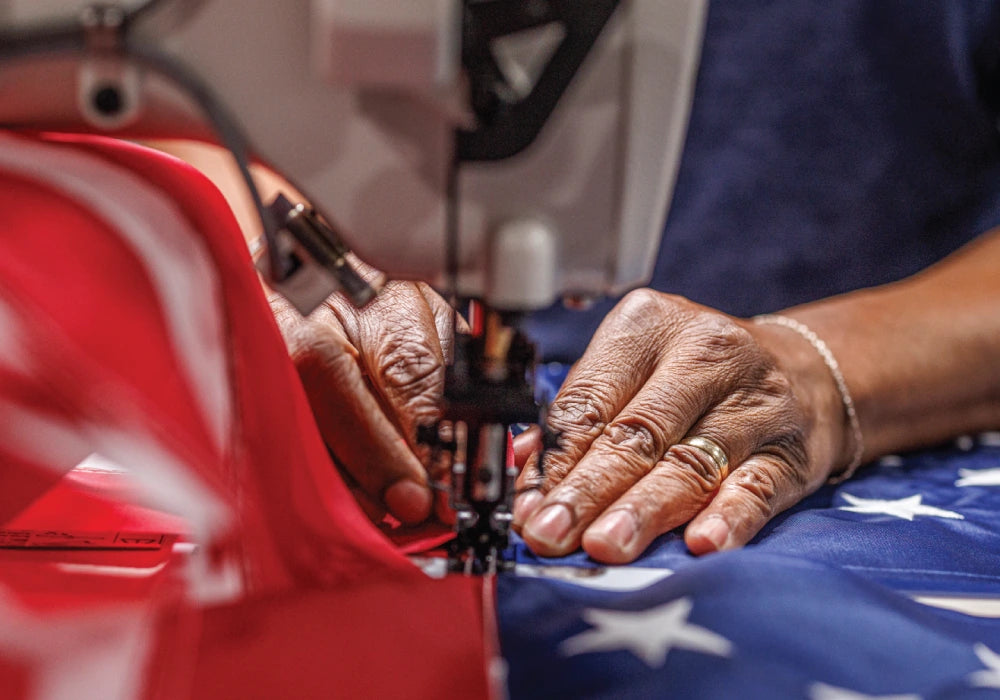Flying the American flag at home is a proud tradition for many, but it requires the right flagpole mounting hardware and know-how to do it properly. Whether you plan to install a towering flagpole in your yard or a porch flagpole mounted to your house, understanding the essential components – from anchors to brackets – is key. In this guide, we'll cover the basics of flagpole anchors and mounts, all-in-one flag and pole kits, installation tips, and how to choose quality flags and poles for residential use.

Types of Flagpoles and Mounting Methods
There are various types of flagpoles, including wall-mounted, in-ground, telescoping, and portable options, as well as the different mounting methods available for each type. First, consider the two main residential options:
-
Wall-Mounted Flagpoles: These are shorter poles (often 5 to 6 feet long) that attach to your house, porch, or garage via a bracket. A wall-mounted flagpole kit is a great solution if you have limited yard space or want an easy installation on the front of your home. The pole is typically installed at an angle (e.g., 45°), keeping the flag conveniently close to the house. Porch flagpoles are popular in neighborhoods (and sometimes required by HOAs) because they are compact yet still display the flag proudly. They’re also relatively affordable and simple to set up.
-
In-Ground Flagpoles: These are the classic freestanding poles installed vertically into the ground. In-ground poles are typically much taller. Installing an in-ground flagpole involves setting a ground anchor in the soil, usually a ground sleeve embedded in concrete, to hold the pole upright. An in-ground pole gives a dramatic, outdoor flagpole display visible from all around, provided you have open space. It’s ideal for larger yards and offers a traditional look, but requires a bit more effort to install. and may be subject to local height or zoning regulations.
Essential Flagpole Mounting Hardware
No matter which type of flagpole you choose, using the proper hardware for a flagpole ensures safety and longevity. Here are the flagpole hardware essentials to know:
-
Mounting Bracket: For wall-mounted setups, a sturdy flagpole mounting bracket is a must. This bracket secures the pole to a wall or post at the desired angle. You can attach a bracket to a porch column, the side of your house near the front door, a fence post, or any solid surface. Quality brackets are typically made of metal for durability. For example, a cast iron bracket from Allegiance Flag Supply comes with three mounting screws and wall anchors for installation. Brackets may offer one fixed angle or be adjustable to multiple angles. Always mount the bracket to a strong structural area using appropriate screws and anchors so the pole will withstand wind.
-
Ground Anchor: For in-ground poles, the anchor is what secures the pole in the earth. Most residential flagpole options use a ground sleeve – typically a PVC or metal sleeve that you set in concrete below ground. The flagpole slides into this sleeve, which anchors it firmly while still allowing removal if needed. The sleeve method disperses the force of wind through the concrete footing. Some larger or surface-mounted poles use an anchor base with anchor bolts that bolt the pole’s base onto a concrete slab, but this is more common for commercial or heavy poles. For most home projects, the included ground sleeve and some quick-dry concrete mix will serve as the anchor to keep your pole upright.
-
Mounting Hardware: Proper fasteners are an often-overlooked but crucial part of flagpole mounting. When attaching a wall bracket, use the supplied mounting screws and, if attaching to brick, stucco, or concrete, the appropriate wall anchors. These anchors expand in the wall material to grip the screw tightly. If mounting to wood, anchors may not be needed, but always pilot-drill holes first to prevent splitting. Ensuring you use the right type of screw and anchors for your wall material will keep the bracket secure through wind and weather.
-
Flag Attachments: To actually connect the flag to the pole, you’ll need attachment hardware. Many house-sized flagpoles use rotating flagpole rings or non-tangle spinners that clip to the flag’s grommets. These rings/spinners spin around the pole with the wind, preventing the flag from wrapping around the pole (a common frustration with flags). Each spinner has a bearing that allows free rotation. Alternatively, larger in-ground poles use simple clip hooks or carabiner-like snap hooks on a halyard rope. Ensure your kit includes the necessary clips or spinning rings to allow your flag to fly freely.
-
Finial (Flagpole Topper): The finial is the ornament at the tip of the pole – commonly a gold ball, eagle, or spear point. While largely decorative, it’s considered an essential part of a flagpole’s appearance. Most kits include a basic gold ball finial that screws onto the top of the pole.
Other flagpole parts you might encounter include halyards, cleats, and flash collars. However, for a standard residential setup, the key components are the hardware described above.
Flag and Pole Kits for Easy Installation
For beginners, purchasing a flagpole installation kit is often the easiest route. A good kit will contain everything you need to mount and fly your flag. Using a complete kit ensures that the pole diameter matches the bracket and that you have the right size flag for the pole. A wall-mounted flagpole kit might come with a 6-foot pole, a 3x5-foot U.S. flag, two spinning attachment rings, and a 45-degree metal bracket, all packaged together. By getting a kit, homeowners can avoid the hassle of purchasing each piece separately. It’s an all-in-one solution – just follow the instructions to assemble the pole, attach the bracket to your porch, and you’ll be ready to raise the flag.
While kits are convenient, advanced users might mix and match components for a customized setup. If you go that route, double-check compatibility (pole diameter vs. bracket, flag size vs. pole height, etc.). But for most residential needs, a quality kit from a reputable American flag store will cover all the essentials in one box.

Commercial Flagpole Accessories
When it comes to commercial-grade flagpoles, the requirements and components differ significantly from those used in typical residential installations. These accessories are designed with security and ease of maintenance in mind, capable of handling larger flags and greater environmental stress from winds, weather, and prolonged use. Heavy-duty hardware for commercial flagpoles includes reinforced halyards, stronger snap hooks or carabiner-style attachments, and robust pulleys or trucks at the pole's top. For security and convenience, internal halyard systems are often used, housing ropes and rigging inside the pole itself to prevent tampering or theft. Internal halyards typically come with a winch mechanism, a lockable access door at the base, and a stainless steel cable for strength and reliability.
Other specialized commercial accessories include sturdy cleats or winches for securing the halyard. Anti-vandalism features such as lockable cleat boxes or halyard covers can also be essential, particularly in public or high-traffic areas. Maintenance-oriented components like rotating trucks or ball-bearing swivels help larger flags rotate smoothly and prevent wrapping, significantly reducing wear on both the flag and the hardware.
Best Practices and Step-by-Step Guidelines for Installing Flagpoles and Displaying Flags
Proper flagpole installation and flag display require attention to detail, respect for flag etiquette, and a focus on safety and durability. Select a suitable location for your flagpole. Choose an area with enough clearance for the flag to fly freely, away from trees, power lines, or buildings that could obstruct the flag or cause it to snag. For in-ground flagpoles, mark the spot and dig a hole at least two feet deep (or as recommended by the manufacturer), ensuring the width is several times the diameter of the pole for added stability. Improve drainage by adding gravel at the bottom of the hole. Insert a ground sleeve vertically in the center, using a level to ensure it is perfectly plumb, and pour concrete around it, leaving the sleeve’s top slightly above ground level to prevent dirt from entering. Allow the concrete to cure fully before continuing. For wall-mounted flagpoles, identify a sturdy structural surface such as a wall stud or solid masonry. Use a mounting bracket made of durable metal, and secure it with suitable screws and wall anchors, following the bracket’s instructions. Always use a level to ensure the bracket is straight, and double-check that all fasteners are tightened securely. In areas prone to strong winds or storms, take down the flag during extreme weather to prevent damage.
Places to Buy U.S. Flags and Flagpoles
Choosing a quality flagpole and flag is just as important as proper installation. A well-made flagpole will withstand outdoor conditions and keep your flag flying proudly for years. For most residential purposes, aluminum flagpoles are an excellent choice. Aluminum is lightweight, strong, and rust-resistant, making it ideal for outdoor poles. Many in-ground and porch poles are made of aluminum. Fiberglass poles exist, too, but they are less common and can be prone to UV damage or cracking over time. If you prefer a more traditional look, wooden flagpoles are used in some house-mounted kits (for example, nicely finished hardwood poles can complement historic homes or porch designs). Just ensure any wood pole is sealed adequately against rot and wear.
For an outdoor flag, look for materials such as nylon or polyester that are specifically designed for all-weather use. Nylon flags are popular for their combination of durability and flyability (they catch breezes well). Polyester is heavier and very sturdy, good for high-wind areas. Also consider the flag's construction. Double-stitched or quadruple-stitched edges and embroidered stars are marks of quality. A cheaply made flag might fray or fade quickly in the sun and rain, whereas a premium U.S. flag will be colorfast and have strong stitching to last through many seasons.
You might wonder where to purchase USA flags and reliable poles or hardware. Rather than a generic big-box store, a dedicated American flag store or reputable online flag retailer is a great choice. Allegiance Flag Supply provides high-quality American flags and flagpole kits, with all components made in the USA. These specialized retailers often offer better craftsmanship and materials. You can trust that a flag from an expert supplier will be built to endure outdoor conditions. When shopping, look for descriptions like “made in USA,” “embroidered,” “heavy-duty,” and check reviews or recommendations for the best quality flags and poles.
Setting up a flagpole at your home is absolutely doable with some basic knowledge of anchors, mounts, and hardware. By selecting the right type of flagpole for your space, using proper mounting equipment, and following installation best practices, you'll ensure your Stars and Stripes are displayed safely and proudly. With a durable flagpole and a high-quality American flag flying proudly, you can showcase your patriotism for years to come.
Sources:
-
Proper flagpole installation and hardware usage guidelines: Home Depot – homedepot.com; ShowAllegiance – showallegiance.com
-
Flagpole kit components and setup advice: ShowAllegiance – showallegiance.com
-
Material and quality recommendations for flags and poles: EM Flag – emflag.com; HD Flagpoles – hdflagpoles.com
-
American flag and flagpole products from Allegiance Flag Supply: ShowAllegiance – showallegiance.com




